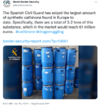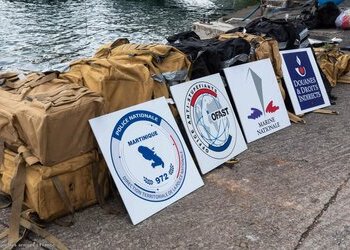The National Police has intervened in a branch of the Russian mafia implanted in Spain in the recording of a meeting in which a payment of up to five million euros was planned to prevent Luis Bárcenas from revealing compromising information for the Government of Mariano Rajoy . The audio was recorded in 2014, in the middle of the National Court's investigation into Genoa's B box and shortly after the SMS sent by the then president of the PP to his treasurer was published, but it had remained secret until now.
The discovery of the recording has surprised the Marbella judge who is investigating the case. The investigations initially focused on a criminal group of Russian origin that extorted compatriots and laundered money from other criminal activities in the provinces of Malaga and Madrid. The Police arrested the seven members of this organization in December 2020 in an operation coordinated by the Anti-Corruption Prosecutor's Office. The alleged ringleader was Halit Sahitaj, a Serb who served as Zakhar Kalashov's lieutenant in Spain , one of the great capos of Russia, who was convicted by the National High Court in 2010 and handed over to Moscow four years later.
Conversación Mónica Gil, José Luis Moreno y Juan Ramón Díaz
Sahitaj continued to live and operate in Spain. The agents searched his house on the Costa del Sol and seized abundant documentation related to extortion and money laundering . Among the digital files that this group hid, the audio related to Bárcenas and the alleged illegal financing of the PP appeared . As sources close to the proceedings have confirmed to El Confidencial, the recording was in one of the email accounts used by Kalashov's right-hand man to send threats and communicate with the rest of the members of his organization.
The 22-minute tape shows the alleged maneuver to grant Kalashov prison benefits in exchange for money and negative information about Bárcenas' environment. In the audio, the voices of three people speaking in perfect Spanish are clearly heard . Although in the conversation they only use their first names, this newspaper has managed to identify them. It is about a lawyer named José Luis Moreno, 'José' in the recording; an alleged businessman, Juan Ramón Díaz, who is referred to as 'Juanra', and a lawyer who is currently in jail, Mónica Gil Manzano, better known as the ' celebrity scammer '', sentenced in 2018 for defrauding former Atlético de Madrid soccer player Mariano Pernía, dancer Joaquín Cortés and the late journalist Mila Ximénez, among other characters from the world of entertainment.
The meeting was held in the office of Mónica Gil, located at that time in the Plaza del Marqués de Salamanca in Madrid. The recording begins with the lawyer introducing the other two participants, who apparently did not know each other until that moment . "José is like my brother (…) So I'll tell you… I told him the subject and that you knew the subject. Well, explain to him what you know," the lawyer asked.
Moreno then took the floor. He said that he was in contact with people from the PP orbit interested in obtaining sensitive information about Javier Gómez de Liaño, the lawyer who at that time was leading the defense of Bárcenas, to force him to stop talking about the party's B box and protect from that way to the Government of Rajoy. "They want to shoot to kill, to kill Liaño, to kill Bárcenas," Moreno said. "They are ready for anything."
People from the orbit of the PP wanted to guarantee the silence of the one who, at that time, was Bárcenas' lawyer, Javier Gómez de Liaño
At that time, 'El Mundo' had already published the messages that the then chief executive had sent to Bárcenas, but in Genoa they feared that new communications would appear. According to Moreno, the PP had sent him to that appointment to obtain data with which to ensure the silence of Gómez de Liaño . The truth is that, at that time, Moreno and another lawyer allegedly involved in the operation and who was arrested a few months ago due to coercion, José Aliste, were moving in the circle of influence in Genoa.
In the audio, Moreno affirms that both he and Aliste knew that Gómez de Liaño had been defending Kalashov . They believed that his colleague could have incurred in irregularities in hiring and charging for his services. The PP's priority was to find evidence to demonstrate these alleged irregularities and put Gómez de Liaño in a bind. "He is very interested. He is very interested and we can benefit him in everything he wants ," Moreno said.
The third interlocutor, Juan Ramón Díaz, alias 'Juanra', listened carefully. He had attended that meeting as a representative of Kalashov, who was serving a sentence in a Spanish prison at the time . Moreno maintained that, in exchange for the Russian mobster providing sensitive information about Gómez de Liaño and paying a large sum of money, a supposed judicial 'lobby' of the PP, which "pressures the different prosecutors from above", was in a position to automatically set your boss free. "Third grade, fourth grade... We have that (...) We are talking about a high level," Moreno slipped. "Freedom in exchange for information, logically."
Kalashov's envoy approved the offer. "Until now, from what they have offered me, it seems to me the most normal, it is the most sensible," considered the alleged representative of the Russian mafia boss. Initially, the plan was that, in addition to the information on Gómez de Liaño, Kalashov would pay a million euros "on success", that is, at the moment in which the alleged 'lobby' of the PP managed to get him out of jail . But Mónica Gil pointed out that the deal was worth "much more" and that it could not be closed for less than five million, according to the recording. However, the figure did not seem to be a problem for Kalashov's envoy either. "I am going to activate this immediately, because it is the most credible right now," Juanra advanced.
Spain handed Kalashov over to Russia in 2014, which immediately released him.
The Police have confirmed the connection of Juan Ramón Díaz with Kalashov and that, indeed, the offer of the supposed lawyer from the orbit of the PP reached the criminal organization. A few hours after the meeting, Kalashov's envoy sent an audio file with the content of the meeting to the email address of the mobster's right-hand man, Halit Sahitaj. The recording is included in the summary and has been analyzed in detail. All the interlocutors have been identified, although it is not related to the core of the complaint that led to the opening of the procedure.
Kalashov finally achieved something better than freedom. At that time, the Georgian authorities demanded his delivery and he was exposed to another long prison sentence in that country. But Spain ended up handing him over in October 2014 to Russia , which immediately left him on the street. There is also no evidence that Bárcenas revealed new messages from Rajoy. Halit Sahitaj and his group are still charged by the Marbella court and Mónica Gil is in jail. The other two attendees at the meeting, José Luis Moreno and Juan Ramón Díaz, have acknowledged to El Confidencial that they participated in that negotiation, but have not provided further explanations.
Narco-sub being built in tiny town reveals Spain as gangland gateway
Police discover new narco-sub under construction in Spain, first known narco-sub constructed in Europe; Suspected boss arrested at the airport carrying plans for sub’s construction. The Mob Reporter here with news of organized crime network busted. Let me tell you about it. The raids are further evidence of the important place Spain now holds as the gangland gateway to Europe. The Costa del Sol is becoming a crowded underworld hotspot. Foreign gangsters are settling in the coastal regions to ensure they get a piece of it — South and Central American narcos, Russian and Eastern European mobsters, Italian Mafia, outlaw bikers, British gangsters, Chinese triads, Moroccan traffickers and others with roots in Northwest Africa but now holding European citizenship. LINK: First narco-submarine captured in Europe — sinks with 3 tons of cocaine: https://youtu.be/XqkUigQ0HIE LINK: Inside narco-sub it's dark and cramped but cops fight over it as a trophy: https://youtu.be/IuGF2E8Bdvw LINK: WILD RIDE | Coast Guard jumps onto fleeing narco-sub in Pacific Ocean: https://youtu.be/TssmEdbW-WA
Possibly related:

Russian President Vladimir Putin Survived Assassination Attempt 2 Months Ago: Report
The assassination attempt took place in Caucasus - a region between Black Sea and the Caspian Sea - shortly after Feb 24, the Ukrainian official said.
The assassination attempt took place in Caucasus - a region between Black Sea and the Caspian Sea - shortly after Feb 24, the Ukrainian official said.
Russian President Vladimir Putin survived an assassination attempt, a Ukrainian military official has said. The admission comes amid the ongoing Russia-Ukraine conflict, which has intensified, and rumours swirling around Mr Putin's health.
According to Major General Kyrylo Budanov, chief of the Defence Intelligence of Ukraine, the “unsuccessful” attempt took place in the Caucasus - a region between the Black Sea and the Caspian Sea - shortly after Russia invaded Ukraine on February 24.
He spoke about the incident to Ukrainska Pravda.
"There was an attempt to assassinate Putin… He was even attacked, it is said, by representatives of the Caucasus, not so long ago,” Mr Budanov was quoted as saying by the Ukrainian outlet.
“This is non-public information. (It was an) Absolutely unsuccessful attempt, but it really happened… It was about 2 months ago,” he added.
Ukrainska Pravda said that the full interview with Mr Budanov will be aired on Tuesday.
The claim has not been verified, but comes weeks after reports emerged that Mr Putin underwent a surgery to remove fluid from his abdomen.
The operation “went well and without complications”, the Express report said, attributing the information to Telegram channel General SVR linked to Russia's Foreign Intelligence Service.
Further, an oligarch with close ties to the Russian leader has reportedly been recorded as saying "Putin is very ill with blood cancer".
Earlier this month, in an interview with Sky News, Mr Budanov predicted that the Ukraine war would reach a turning point by mid-August and be over by the end of this year, leading to change of leadership in Russia.
He had also claimed that a coup to overthrow Russian President Vladimir Putin is underway and cannot be stopped.
As far as Mr Putin is concerned, he publicly disclosed in 2017 that he has survived as least five assassination attempts and claimed that he wasn't worried about his safety.
FlashBack
Mar 16, 2022

























